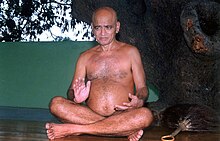
Digambara (/dɪˈɡʌmbərə/; Sanskrit: दिगंबर, "sky-clad") is a sect of Jainism with nudist adherents that distinguished itself from the white-clad Śvētāmbara in about the 3rd century AD.[1] The Digambar sect of Jainism rejects the authority of the Jain Agama compiled by Sthulabhadra.[2] They believe that by the time of Dharasena, the twenty-third teacher after Gandhar Gautama, knowledge of only one Anga was there. This was about 683 years after the Nirvāṇa of Mahavir. After Dharasena's pupils Puspadant and Bhutabali, even that was lost.[3]
According to Digambar tradition, Mahavir, the last jain tirthankara, never married. He renounced the world at the age of thirty after taking permission of his parents.[4] The Digambara believe that after attaining enlightenment, Mahavira was free from human activities like hunger, thirst, and sleep.[5] Monks in the Digambar tradition do not wear any clothes. They carry only a broom made up of fallen peacock feathers and a water gourd.[6] One of the most important scholar-monks of Digambara tradition was Acharya Kundakunda. He authored Prakrit texts such as Samayasar and Pravachansar. Samantabhadra and Siddhasena Divakara were other important monks of this tradition.[7]
The scriptures Shatkhand-agama and Kasay-pahuda are regarded to be of major significance in the Digambara tradition.[8]
Digambar monasticism

The prominent Acharyas of the Digambar tradition were Kundakunda (author of Samayasar and other works),[9] Virasena (author of a commentary on the Dhavala).[10]
In the 10th century, Digambar tradition was divided into two main orders.
- Mula Sangh, which includes Sena gana, Deshiya gana and Balatkara gana traditions
- Kashtha Sangh, which includes the Mathura gana and Lat-vagad gana traditions
Shantisagar, belonged to the tradition of Sena gana. Practically all the Digambara monks today belong to his tradition, either directly or indirectly. The Bhattarakas of Shravanabelagola and Mudbidri belong to Deshiya gana and the Bhattaraka of Humbaj belongs to the Balatkara gana.[11]
Vows
Every Digambara monk has to compulsory follow the below mentioned 28 vows (vrats)
See also
Notes
- ^ Singh 2008, p. 23
- ^ Singh 2008, p. 444
- ^ Dundas 2002, p. 79
- ^ Singh 2008, p. 313
- ^ Singh 2008, p. 314
- ^ Singh 2008, p. 316
- ^ Singh 2008, p. 524
- ^ Dundas 2002, p. 63-64.
- ^ Gender and Salvation: Jaina Debates on the Spiritual Liberation of Women - Padmanabh S. Jaini - Google Books. Books.google.com. Retrieved 2013-09-29.
- ^ Satkhandagama : Dhaval (Jivasthana) Satparupana-I (Enunciation of Existence-I) An English Translation of Part 1 of the Dhavala Commentary on the Satkhandagama of Acarya Pushpadanta & Bhutabali Dhavala commentary by Acarya Virasena English tr. by Prof. Nandlal Jain, Ed. by Prof. Ashok Jain ISBN : 8186957472, 9788186957479
- ^ Jaina Community: A Social Survey - Vilas Adinath Sangave - Google Books. Books.google.com. Retrieved 2013-09-29.
References
- Singh, Upinder (2008), A History Of Ancient And Early Medieval India: From The Stone Age To The 12Th Century, Pearson Education India, ISBN 978-81-317-1120-0
- Dundas, Paul (2002), Jains, Routledge, ISBN 978-0-415-26606-2
- Jones, Constance; Ryan, James D. (2006), Encyclopedia of Hinduism, Infobase Publishing, ISBN 978-0-8160-7564-5
| Gods | |||||
|---|---|---|---|---|---|
| Philosophy | |||||
| Branches |
| ||||
| Practices | |||||
| Literature | |||||
| Symbols | |||||
| Ascetics | |||||
| Scholars | |||||
| Community | |||||
| Jainism in |
| ||||
| Jainism and | |||||
| Dynasties and empires | |||||
| Related | |||||
| Lists | |||||
| Navboxes | |||||